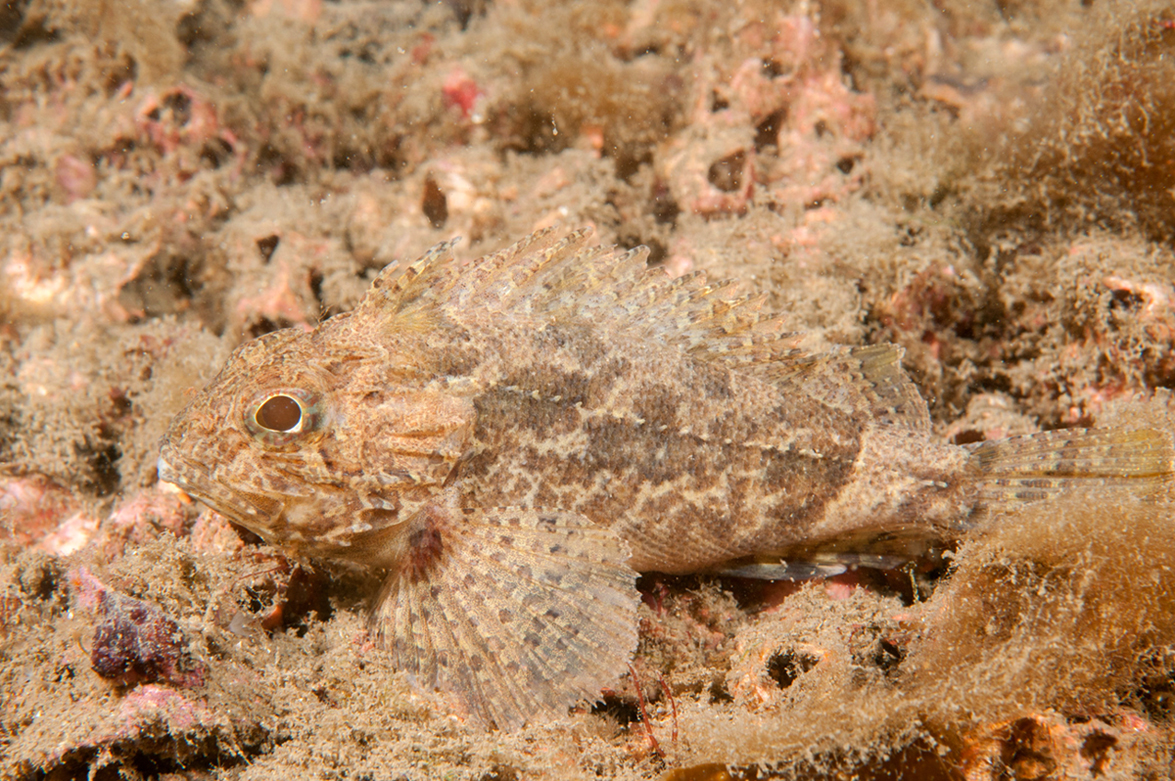Marbled Fortescue, Centropogon marmoratus Günther 1862
Other Names: Bullrout, Cobbler

A Marbled Fortescue, Centropogon marmoratus, at Clifton Gardens, Sydney Harbour, New South Wales, September 2019. Source: Erik Schlogl / iNaturalist.org. License: CC By Attribution-NonCommercial
Summary:
A fortescue with a marbled or mottled pattern on the head and body, and a narrow naked area on the nape and along the spinous dorsal-fin base.
This species has long been confused with the Fortescue, Centropogon australis, which has a pattern of irregular bands on the body, longer dorsal-fin spines and a broad naked area between the lateral line and the base of the spinous dorsal fin.
The fin spines are venomous and may inflict a very painful sting.
This species has long been confused with the Fortescue, Centropogon australis, which has a pattern of irregular bands on the body, longer dorsal-fin spines and a broad naked area between the lateral line and the base of the spinous dorsal fin.
The fin spines are venomous and may inflict a very painful sting.
Cite this page as:
Bray, D.J. 2020, Centropogon marmoratus in Fishes of Australia, accessed 18 Apr 2024, https://fishesofaustralia.net.au/Home/species/4045
Marbled Fortescue, Centropogon marmoratus Günther 1862
More Info
|
Distribution |
Endemic to eastern Australia, from Gladstone, Queensland, to at least Sydney, New South Wales. Inhabits silty/sand and seagrass areas in bays, estuaries and sheltered coastal waters. |
|
Features |
|
|
Similar Species |
Differs from the Eastern Fortescue, Centropogon australis, in having a mottled/marbled pattern on the body (vs. irregular bands), shorter dorsal-fin spines, the jaw of moderate length, 15-19% SL (versus 10-15% in C. australis), relatively weak interorbital ridges, and a narrow naked area on the nape and along the spinous dorsal-fin base (vs. a broad naked area between the base of the spinous dorsal fin and the lateral line in C. australis). |
|
Etymology |
The specific name is from the Latin marmoratus (= marbled) in reference to the marbled pattern on the head and body. |
|
Species Citation |
Centropogon marmoratus Günther 1862, Proceedings of the Zoological Society of London 1862(2): 190 [3], pl. 27(fig. B). Type locality: Moreton Bay, Queensland. |
|
Author |
Bray, D.J. 2020 |
|
Resources |
Marbled Fortescue, Centropogon marmoratus Günther 1862
References
Chungthanawong, S. & Motomura, H. 2018. Two new species of the waspfish genus Ablabys (Scorpaeniformes: Tetrarogidae) from the western Pacific Ocean. Ichthyological Research 66(1): 114–128a https://doi.org/10.1007/s10228-018-0665-0
De Vis, C.W. 1884. Fishes from South Sea islands. Proceedings of the Linnean Society of New South Wales 8(4): 445-457 (as Tetraroge vestitus) See ref at BHL
Grant, E.M. 1975. Guide to Fishes. Brisbane : Queensland Government, Co-ordinator General’s Department 640 pp.
Günther, A. 1862. Descriptions of new species of reptiles and fishes in the collection of the British Museum. Proceedings of the Zoological Society of London 1862(2): 188-194 pls 25-27 See ref at BHL
Günther, A. 1862. Descriptions of new species of reptiles and fishes in the collection of the British Museum. Annals and Magazine of Natural History 3 11(62): 134–140
Johnson, J.W. 1999. Annotated checklist of the fishes of Moreton Bay, Queensland, Australia. Memoirs of the Queensland Museum 43(2): 709-762 See ref at BHL
Johnson, J.W. 2010. Fishes of the Moreton Bay Marine Park and adjacent continental shelf waters, Queensland, Australia. pp. 299-353 in Davie, P.J.F. & Phillips, J.A. Proceedings of the Thirteenth International Marine Biological Workshop, The Marine Fauna and Flora of Moreton Bay. Memoirs of the Queensland Museum 54(3)
Kuiter, R.H. 1996. Guide to Sea Fishes of Australia. A comprehensive reference for divers and fishermen. Sydney, NSW, Australia : New Holland Publishers xvii, 434 pp.
Poss, S.G. 1999. Families Scorpaenidae, Caracanthidae, Aploactinidae. pp. 2291-2358 in Carpenter, K.E. & Niem, T.H. (eds). The Living Marine Resources of the Western Central Pacific. FAO Species Identification Guide for Fisheries Purposes. Rome : FAO Vol. 4 pp. 2069-2790.









